Schools throughout the country have been developing and refining their local curriculum documents. Local Curriculum weaves the elements of the national curriculum framework within local contexts to provide rich learning opportunities. This has required extensive consultation and collaboration with the whole school community. In the Taupō district Enviroschools Facilitator, Jenni, has been working with 2 rural schools to align their vision and mission statements with the Enviroschools kaupapa.
Mangakino and Tirohanga are both small schools in the Taupō District. Their rural setting and expansive school grounds provide numerous opportunities for ākonga to be experiencing and connecting with the natural environment.
Both schools have relatively new principals and were looking for relevant scaffolding to negotiate design of their Local Curriculum. Jenni helped this process by facilitating the exploration of the Enviroschools kaupapa and Guiding Principles and unpacking the resources.
Central to Enviroschools learning is providing opportunities for young people to explore their school and wider environment through a range of experiences. These include sensory/observational activities, investigating, measuring and auditing, and seeing the world through different lenses.
Your local curriculum should be unique and responsive to the priorities, preferences, and issues of your community and your people. What is important is that all elements of The New Zealand Curriculum are used as the framework in designing your local curriculum. This ensures you’re supporting the strengths of all of your learners. – from MoE NZ Curriculum online
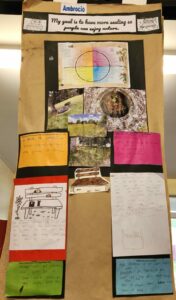
The Action Learning Cycle guiding ākonga and kaiako.
With a MoE consultant to help develop the Local Curriculum, Tirohanga staff set out 2 non-negotiable aspects to weave through their design: ES kaupapa and Universal Design for learning pedagogy (that supports the passion that principal, Tracey McConachie, has to honour students’ diversity, strengths and needs).
The Enviroschools kaupapa aligns so conclusively with their consultation results, and has shaped the adaption of a 5-year rotation of contexts for learning, built around the 5 Enviroschools Theme Areas. Each term as the school year progresses contexts will be explored first within the school lens, next local, next national and in Term 4 it’s a global application.
Tirohanga staff and students are now familiar with the Enviroschools Action Learning Cycle, with the seniors using it as a guide for their individual projects with fantastic results, showing depth in their personal inquiries.

Our school vision is ‘Nurtured by Nature, Responsive Learning Through Our Environment’ where we are focused on providing rich learning experiences by exploring the school and local environments. Using the Enviroschools Action Learning Cycle, and Guiding Principles to underpin our practice, students are empowered to participate in meaningful ways in their community. Their unique perspectives and questions are valued and honoured. They feel connected to the whenua and support each other as a learning community to create meaningful change and hopeful action. Through this we weave numeracy and literacy into our learning, as well as through deliberate instructional teaching. https://www.tirohanga.school.nz/
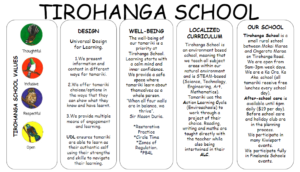
Tirohanga School values and overarching vision
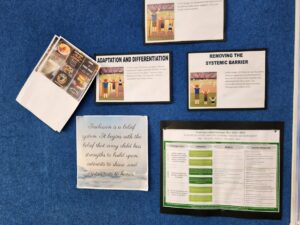
Tirohanga strategic planning documents.
Tirohanga Principal, Tracey McConachie
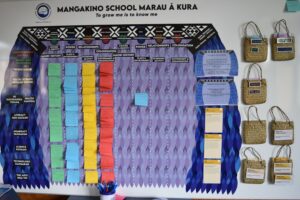
Mangakino vision and strategy proudly displayed for everyone to engage with.
Principal, Cherie Hill, Mangakino School, has developed a large whiteboard printed with a grid with headings to align key values, kaupapa and local culture with curriculum areas. It is printed on a korowai, significant to the Mangakino community, reflecting the dominant culture there. Sticky notes are added by staff and education professionals and parents in each grid square noting potential resources, learning opportunities and actions relevant to the term’s learning intentions. The planning board spans a 2-year cycle. It is easily accessed by everyone as it is on a wall in the staffroom where it is clear to all what should be currently happening, and what is next.
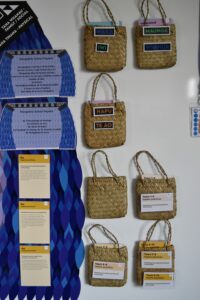
Consolidating what is important and under-pinning it with good pedagogy.
Jenni spent time with Cherie unpacking resources relevant to each of the learning contexts as Enviroschools resources provide deep learning through meaningful, interactive and locally relevant experiences. Page references and other linked activities are added to an identical grid to the overall planning grid, ready to be chosen from and adopted quickly and easily.
Attached along the right-hand side of the planning board, in kete, are cards from the Aotearoa New Zealand Histories curriculum documents.

“Our Localised Curriculum is focused on health and well-being, immersing our students into our stunning natural environment, and strengthening our foundations through the rich history that identifies us as people.” – Mangakino School website https://www.mangakino.school.nz/home

Understanding the current situation and exploring opportunities.
The first two terms of use indicate that the approach is effective.